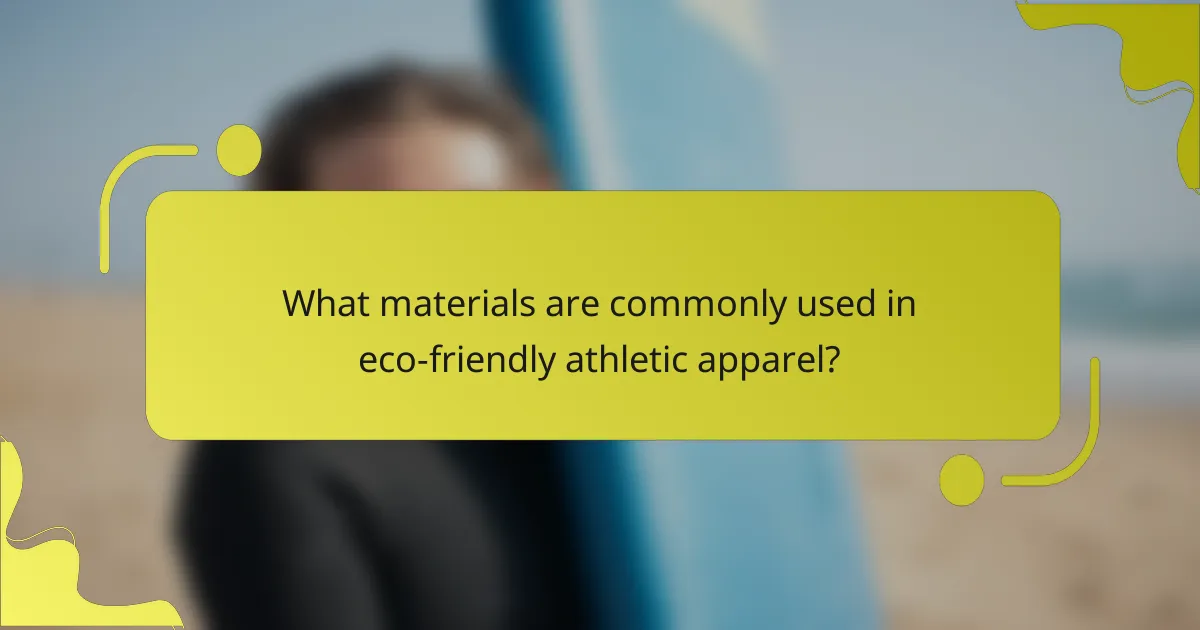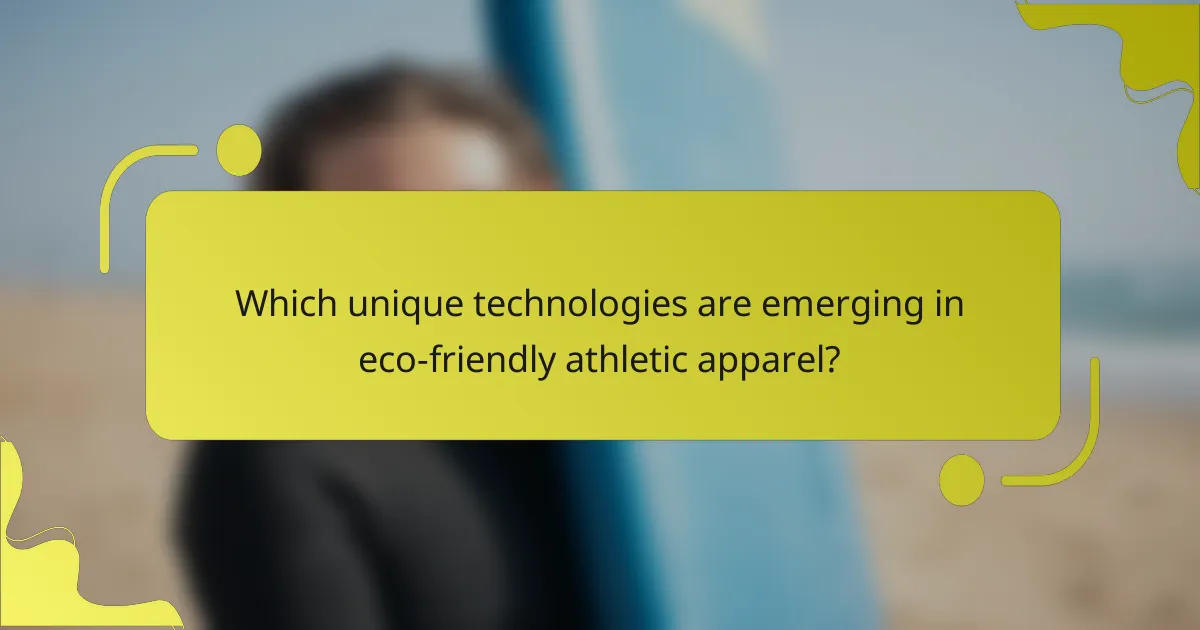Eco-friendly athletic apparel offers a sustainable alternative for consumers concerned about environmental impact. This article explores the materials used, including organic cotton and recycled polyester, highlights the benefits of reduced pollution and ethical production, and examines current market trends driving growth in this sector. With consumer demand for responsible choices on the rise, understanding these aspects is essential for making informed purchasing decisions.

What materials are commonly used in eco-friendly athletic apparel?
Eco-friendly athletic apparel commonly uses materials such as organic cotton, recycled polyester, Tencel, hemp, and bamboo. These materials reduce environmental impact while providing comfort and durability. Organic cotton is grown without harmful pesticides, recycled polyester repurposes plastic waste, and Tencel is made from sustainably sourced wood. Hemp is known for its strength and low water usage, while bamboo offers natural moisture-wicking properties. These attributes contribute to the growing market trend towards sustainable fashion.
How do these materials impact performance and comfort?
Eco-friendly athletic apparel significantly enhances performance and comfort through advanced materials. These materials often feature moisture-wicking properties, breathability, and lightweight designs that improve movement. For instance, recycled polyester offers durability while reducing environmental impact. Additionally, organic cotton provides softness and comfort, making it suitable for long wear. As a result, athletes experience less irritation and better temperature regulation during physical activities.
Which brands are leading in sustainable fabric innovation?
Leading brands in sustainable fabric innovation include Patagonia, Nike, Adidas, and Reebok. These companies focus on eco-friendly materials like recycled polyester and organic cotton. Patagonia pioneered the use of recycled materials, committing to 100% renewable energy in production. Nike’s Move to Zero initiative emphasizes reducing waste and carbon emissions. Adidas has developed a line using ocean plastic, showcasing a commitment to marine conservation. Reebok highlights plant-based materials, setting a trend in the industry. These brands are shaping the future of eco-friendly athletic apparel.

What are the environmental benefits of choosing eco-friendly athletic apparel?
Choosing eco-friendly athletic apparel significantly reduces environmental impact. These garments often use sustainable materials, minimizing pollution and resource depletion. For instance, organic cotton and recycled polyester require less water and energy compared to conventional fabrics.
Additionally, eco-friendly production processes lower carbon emissions. Brands prioritizing sustainability often implement fair labor practices, supporting ethical manufacturing. As a result, consumers contribute to a healthier planet while promoting responsible consumption.
The market for eco-friendly athletic apparel is growing rapidly, reflecting increased consumer awareness. In 2022, the global sustainable apparel market was valued at approximately $6.35 billion, indicating a strong trend towards environmentally conscious choices. This shift benefits both the environment and the economy, fostering innovation in sustainable materials and practices.
How does sustainable apparel reduce carbon footprint?
Sustainable apparel reduces carbon footprint by using eco-friendly materials and ethical manufacturing processes. These practices minimize resource consumption and waste generation. For example, organic cotton uses less water and avoids harmful pesticides, while recycled polyester reduces reliance on fossil fuels. Additionally, local production lowers transportation emissions.
What role does recycling play in eco-friendly athletic wear?
Recycling plays a crucial role in eco-friendly athletic wear by reducing waste and conserving resources. It allows brands to create garments from recycled materials, such as plastic bottles, which lowers the environmental impact. This process not only minimizes landfill contributions but also decreases the need for virgin materials, thereby saving energy and reducing carbon emissions. Additionally, using recycled content can enhance the unique attributes of athletic apparel, such as moisture-wicking properties and durability, appealing to environmentally conscious consumers.

How is consumer demand for eco-friendly athletic apparel changing in 2025?
Consumer demand for eco-friendly athletic apparel is expected to grow significantly in 2025. This shift is driven by increased awareness of sustainability and the environmental impact of fashion.
Consumers are prioritizing materials such as organic cotton, recycled polyester, and Tencel, which offer both performance and reduced ecological footprints. As a result, brands are innovating to create high-quality products that align with these values.
Market trends indicate a rise in companies adopting transparent supply chains, showcasing their eco-friendly practices. This transparency builds trust and encourages consumer loyalty, further fueling demand.
The unique attribute of eco-friendly athletic apparel is its dual focus on performance and sustainability, appealing to environmentally conscious consumers. This trend is expected to reshape the athletic apparel landscape in the coming years.
Which demographics are most interested in sustainable athletic wear?
Millennials and Gen Z are the demographics most interested in sustainable athletic wear. These groups prioritize environmental impact and ethical production in their purchasing decisions. Research indicates that 73% of younger consumers are willing to pay more for eco-friendly products. Additionally, women show a stronger preference for sustainable options compared to men. As a result, brands targeting these demographics focus on transparency and sustainable materials.
What marketing strategies are effective for eco-friendly brands?
Eco-friendly brands should focus on transparency, community engagement, and sustainable storytelling. These strategies build trust and connect with environmentally conscious consumers. Highlighting the use of organic materials and ethical production processes enhances brand credibility. Collaborating with eco-activists and influencers can expand reach and amplify messaging. Additionally, leveraging social media for awareness and education fosters a loyal customer base.

What challenges do brands face in producing eco-friendly athletic apparel?
Brands face several challenges in producing eco-friendly athletic apparel, including sourcing sustainable materials, managing production costs, and meeting consumer expectations. Sourcing eco-friendly fabrics, such as organic cotton or recycled polyester, can be difficult due to limited availability and higher prices. Production costs often rise when using sustainable processes, which can affect pricing strategies. Additionally, brands must navigate consumer skepticism regarding the authenticity of eco-friendly claims, requiring transparency and education to build trust. Finally, balancing style and performance with sustainability can complicate design choices, as athletes seek both functionality and environmental responsibility.
How do supply chain issues affect sustainability in athletic wear?
Supply chain issues can significantly hinder sustainability in athletic wear by increasing waste and carbon emissions. Disruptions often lead to overproduction, resulting in unsold inventory that contributes to landfill waste. Additionally, sourcing materials from distant suppliers raises transportation emissions, undermining the eco-friendly goals of brands. As a result, brands must prioritize local sourcing and efficient logistics to enhance sustainability.
What are the common misconceptions about eco-friendly materials?
Many misconceptions exist about eco-friendly materials in athletic apparel. One common belief is that they are less durable than conventional options. In reality, many eco-friendly materials, such as recycled polyester, offer comparable durability and performance. Another misconception is that eco-friendly fabrics are always more expensive; however, prices can vary widely based on the brand and material sourcing. Some consumers also think that eco-friendly options limit style and design, but innovative brands are creating fashionable and functional athletic wear from sustainable materials. Lastly, there is a belief that all eco-friendly materials are biodegradable, which is not true; some, like certain synthetics, may not decompose easily.

Which unique technologies are emerging in eco-friendly athletic apparel?
Innovative technologies in eco-friendly athletic apparel include bio-based materials, recycled fabrics, and smart textiles. These advancements enhance sustainability while improving performance. For example, brands utilize algae-based fibers and plastic waste to create lightweight, breathable clothing. Additionally, moisture-wicking and temperature-regulating properties are integrated through advanced textile engineering.
How is 3D printing being used in sustainable athletic wear production?
3D printing is revolutionizing sustainable athletic wear production by enabling the use of eco-friendly materials and reducing waste. This technology allows brands to create customized designs while minimizing excess fabric and energy consumption. For instance, companies are utilizing recycled plastics and biodegradable filaments in their 3D printing processes. As a result, the market sees a rise in apparel that not only meets performance standards but also aligns with environmental sustainability goals.
What innovations are enhancing the durability of eco-friendly fabrics?
Innovations enhancing the durability of eco-friendly fabrics include advanced textile treatments, sustainable fibers, and innovative weaving techniques. These developments improve resistance to wear and tear while maintaining environmental integrity. For instance, recycled polyester blends increase longevity without compromising sustainability. Additionally, bio-based coatings enhance water resistance, extending the life of athletic apparel. As a result, brands can offer products that meet performance demands and eco-conscious consumer preferences.

What trends are shaping the future of eco-friendly athletic apparel?
Sustainability, innovation, and consumer demand are shaping the future of eco-friendly athletic apparel. Brands increasingly use recycled materials, such as ocean plastics and organic cotton, which reduce environmental impact. The market shows a growing preference for transparency in sourcing and production practices, with consumers valuing ethical standards. Additionally, advancements in technology enable the creation of performance fabrics that are both eco-friendly and functional, enhancing the appeal of these products.
How are collaborations between brands and environmental organizations influencing the market?
Collaborations between brands and environmental organizations are significantly shaping the eco-friendly athletic apparel market. These partnerships enhance credibility and foster innovation in sustainable materials. For instance, brands like Adidas and Parley for the Oceans utilize recycled ocean plastic in their products, appealing to environmentally conscious consumers. This trend not only drives sales but also promotes awareness about sustainability in fashion. As a result, the market is witnessing a shift towards more responsible production practices and consumer preferences for eco-friendly options.
What role does consumer education play in the growth of sustainable apparel?
Consumer education is crucial for the growth of sustainable apparel as it drives informed purchasing decisions. Educated consumers prioritize eco-friendly materials, understanding their benefits, such as reduced environmental impact and improved health. For example, awareness of organic cotton versus conventional cotton influences consumer choices, promoting brands that align with sustainable practices. As a result, increased demand for sustainable options encourages manufacturers to adopt greener methods, fostering market growth.
What best practices should consumers follow when purchasing eco-friendly athletic apparel?
Consumers should prioritize sustainable materials, ethical production, and certifications when purchasing eco-friendly athletic apparel. Look for organic cotton, recycled polyester, and Tencel, as these materials reduce environmental impact. Verify brands’ commitment to ethical labor practices and transparency in their supply chains. Certifications like Global Organic Textile Standard (GOTS) or OEKO-TEX can further assure quality and sustainability. Additionally, consider the durability and lifecycle of the apparel, as longer-lasting products contribute to less waste.




